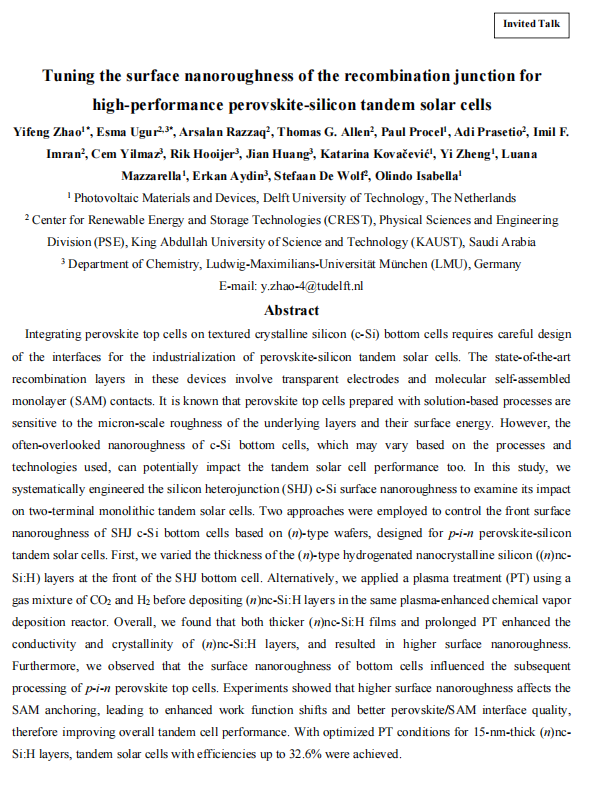| Tuning the surface nanoroughness of the recombination junction for high-performance perovskite-silicon tandem solar cells【Yifeng Zhao】 |
| 发布时间:2025-11-06 | 浏览次数:124 |
high-performance perovskite-silicon tandem solar cells Yifeng Zhao1*, Esma Ugur2,3*, Arsalan Razzaq2, Thomas G. Allen2, Paul Procel1, Adi Prasetio2, Imil F. Imran2, Cem Yilmaz3, Rik Hooijer3, Jian Huang3, Katarina Kovačević1, Yi Zheng1, Luana Mazzarella1, Erkan Aydin3, Stefaan De Wolf2, Olindo Isabella1 1 Photovoltaic Materials and Devices, Delft University of Technology, The Netherlands 2 Center for Renewable Energy and Storage Technologies (CREST), Physical Sciences and Engineering Division (PSE), King Abdullah University of Science and Technology (KAUST), Saudi Arabia 3 Department of Chemistry, Ludwig-Maximilians-Universität München (LMU), Germany E-mail: y.zhao-4@tudelft.nl Abstract Integrating perovskite top cells on textured crystalline silicon (c-Si) bottom cells requires careful design of the interfaces for the industrialization of perovskite-silicon tandem solar cells. The state-of-the-art recombination layers in these devices involve transparent electrodes and molecular self-assembled monolayer (SAM) contacts. It is known that perovskite top cells prepared with solution-based processes are sensitive to the micron-scale roughness of the underlying layers and their surface energy. However, the often-overlooked nanoroughness of c-Si bottom cells, which may vary based on the processes and technologies used, can potentially impact the tandem solar cell performance too. In this study, we systematically engineered the silicon heterojunction (SHJ) c-Si surface nanoroughness to examine its impact on two-terminal monolithic tandem solar cells. Two approaches were employed to control the front surface nanoroughness of SHJ c-Si bottom cells based on (n)-type wafers, designed for p-i-n perovskite-silicon tandem solar cells. First, we varied the thickness of the (n)-type hydrogenated nanocrystalline silicon ((n)nc-Si:H) layers at the front of the SHJ bottom cell. Alternatively, we applied a plasma treatment (PT) using a gas mixture of CO2 and H2 before depositing (n)nc-Si:H layers in the same plasma-enhanced chemical vapor deposition reactor. Overall, we found that both thicker (n)nc-Si:H films and prolonged PT enhanced the conductivity and crystallinity of (n)nc-Si:H layers, and resulted in higher surface nanoroughness. Furthermore, we observed that the surface nanoroughness of bottom cells influenced the subsequent processing of p-i-n perovskite top cells. Experiments showed that higher surface nanoroughness affects the SAM anchoring, leading to enhanced work function shifts and better perovskite/SAM interface quality, therefore improving overall tandem cell performance. With optimized PT conditions for 15-nm-thick (n)nc-Si:H layers, tandem solar cells with efficiencies up to 32.6% were achieved.
|






